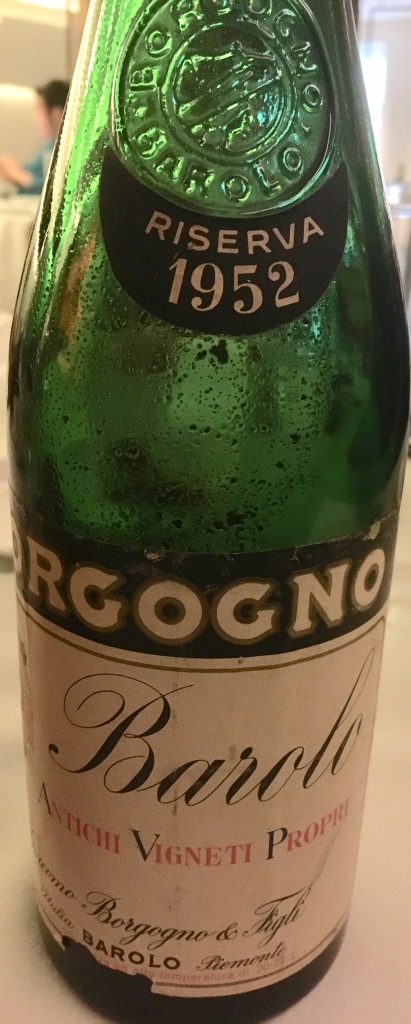This is Part II of the Zoom tasting A Taste of Italy with Doctor Wine that took place last week hosted by Daniele Cernilli (aka)Doctor Wine There were 9 wines and in the first blog I wrote about 4 wines. Here are the other 5 wines.
The samples were in very small 5 cl bottles with twist off caps. Each bottle had a label and a number so there would be no confusion. The whole program was well organized and very informative.
The Wines
Doc APE 2018 Cantine Romagnoli (EMILIA ROMAGNA) made from 55% Barbera, 45% Croatina (Bonarda). The soil is calcareous, medium texture tending to sandy. There are 3,600 plants/hectare and the pruning system is simple guyot. The exposure is south. The grapes macerate for 9 days with a daily pumping over. Fermentation with selected yeasts. The wine ages in first and second passage barriques for 12 months. Then there is the assemblage, a light clarification and a final filtration. The wine has hints of ripe fruit, licorice, leather and a note of wood and tobacco.
A.A. Pinot Nero Riserva “ Zeno” 2018 Cantina Merano made from 100% Pinot Nero (Trentino-Alto Adige, South Tyrol). The vineyards are at 500-700 meters and the vines are 15 to 20 years old. The soil is morainic, light, permeable, decomposed slate, granite and gneiss, barren and sandy. There is a cold fermentation for 5 days, then controlled fermentation with stirring for about 12 days. Aging is in new and used tonneaux. This is an elegant wine with hints of wild berries like strawberries and cherries and a long finish. Daniele liked the wine and included it in the current edition of his The Essential Guide to Italian Wine.

Barberasso 2018 Castello Cigognola (Lombardy–Oltrepo Pavese-Pavia, across the Po) made from 100% Barbera. This is a new wine made from experimenting in the vineyard with cuttings of the branch of the vine. This is an ancient technique, which allows for a light drying of the grapes while keeping the bunch on the plant and in the sunlight. The grapes increase their concentration and continue to develop substances in the peel, which intensify the aromas. They combine the raisin grape and the natural acidity of Barbera with partial whole bunch fermentation to create a new wine. This results in a wine where fruit and acidity are counterbalanced by a soft light note of ripe fruit. Half of the wine is aged for 10 months in 600-liter tonneaux. Because of the raisin fruit, the wine has about 7.5% grams of natural sugar making it softer. The wine has hints of ripe red fruit, strawberries, raspberries and a touch of raisins. This is the first time I have tasted a wine made in this way.
Lazio IGP 2017 Montiano Cotarella (Lazio) made from 100% estate grown Merlot from Montefiascone and Castiglione in Teverina. The vineyard is 86.4 acres at 300 meters. The soil is volcanic and rich in fine gravel (Scheletro). There are 1,700 vines per hectare and the training system is guyot. The average age of the vines is 16 years. Only the best clusters are harvested by hand during the first week of September. A second selection takes place at the winery. Maceration on the skins takes place for 10 days with numerous punch-downs. Temperature controlled fermentation is in truncoconic stainless steel tanks and malolactic takes place in barrel. The wine ages for 12 months in new French oak. It has hints of red and black berries, spice and vanilla with a touch of cedar. Daniele was impressed with this wine.
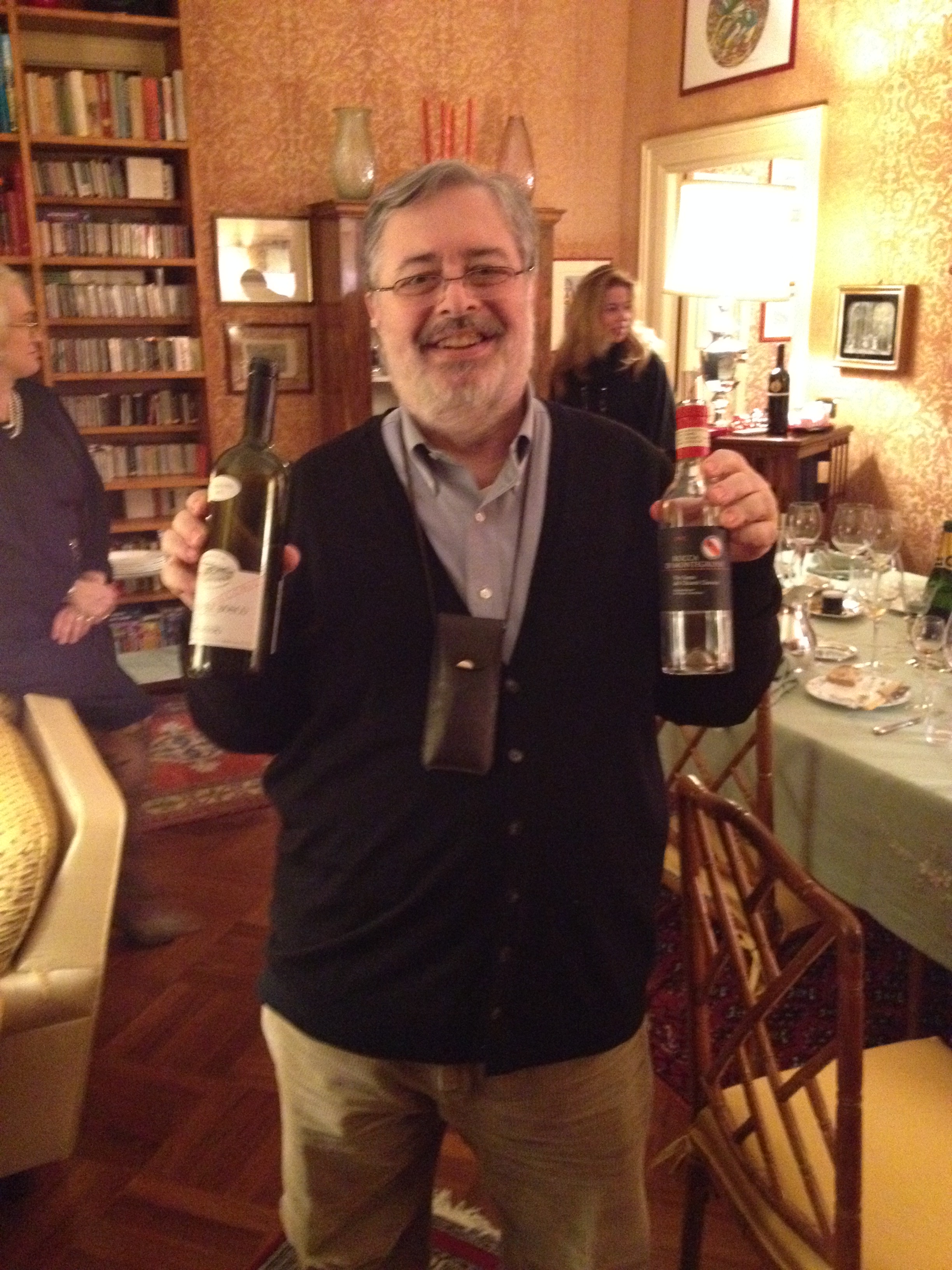
Daniele Cernilli -Doctor Wine
Primitivo IGP Puglia 2018 “Ipnotico” Terre Dei Vaaz (Puglia) made from 100% monovarietal Primitivo. Production area is the Murgia plateaux. The soil is medium textured and the elevation is 340 to 380 meters. There are 2800 plants per hectare, the planting system is sapling vineyards and the average age of the wines is 60 years. Fermentation takes place in steel tanks. The wine is aged for 12 months in stainless steel, 4 months in French barriques and a minimum of 8 months in bottle. The wine has hints of sour cherries, prunes, a touch of pomegranate and a note of chocolate with a long finish.

 Nine wines from different regions of Italy arrived so that participants could taste and discuss. The samples were sent in very small bottles with twist off caps.
Nine wines from different regions of Italy arrived so that participants could taste and discuss. The samples were sent in very small bottles with twist off caps.

 We started with crostini covered with homemade roasted red peppers and anchovies.
We started with crostini covered with homemade roasted red peppers and anchovies. Champagne Empreintes 2012 Extra Brut Laherte Frere made from 50% Chardonnay from vines in Les Chemins d’Epernay which were planted in 1957 and 50% Pinot Noir from vines in Les Rouges Maisons planted in 1983. Multiple parcels with varied exposure. Les Chemins d’Epernay has clay soil with a silt stratum in surface and a chalky subsoil. Rouges Maisons has a deep clay topsoil with flint, schist and a chalk subsoil. The vineyards are farmed organically, sometime by horse. Hand harvesting takes place when grapes are fully ripe. Traditional pressing. Natural alcoholic fermentation in barrels from Burgundy aged for a minimum of 10 years. There is no malolactic fermentation. Six months of barrel aging with regular stirring of the lees. Disgorged by hand 01/2018 with a 3 gr/l dosage. It has hints of yellow plums, citrus fruit, peaches, good minerality, a touch of pepper and a note of spice.
Champagne Empreintes 2012 Extra Brut Laherte Frere made from 50% Chardonnay from vines in Les Chemins d’Epernay which were planted in 1957 and 50% Pinot Noir from vines in Les Rouges Maisons planted in 1983. Multiple parcels with varied exposure. Les Chemins d’Epernay has clay soil with a silt stratum in surface and a chalky subsoil. Rouges Maisons has a deep clay topsoil with flint, schist and a chalk subsoil. The vineyards are farmed organically, sometime by horse. Hand harvesting takes place when grapes are fully ripe. Traditional pressing. Natural alcoholic fermentation in barrels from Burgundy aged for a minimum of 10 years. There is no malolactic fermentation. Six months of barrel aging with regular stirring of the lees. Disgorged by hand 01/2018 with a 3 gr/l dosage. It has hints of yellow plums, citrus fruit, peaches, good minerality, a touch of pepper and a note of spice. Here are the sea urchins, which we were able to purchase removed from their shells.
Here are the sea urchins, which we were able to purchase removed from their shells. Spaghetti with sea urchin, garlic, tomatoes and parsley Procida-style. Ready to be served
Spaghetti with sea urchin, garlic, tomatoes and parsley Procida-style. Ready to be served The spaghetti on the plate, topped with more sea urchin.
The spaghetti on the plate, topped with more sea urchin. Beneventano Falanghina 2018 Donnachiara made from 100% Falanghina. The vineyard is the Torre Cuso, the best location for Falanghina. The soil is volcanic, chalky clay, the vines are 16 years old, the training system is guyot and there are 2,500 vines per hectare. The grapes are not destemmed or crushed before pressing. Cold fermentation is in stainless steel and there is extended maceration. This is a crisp white wine with citrus fruit aromas and flavors, nice acidity and good minerality. It is one of my favorite white wines and my friend, who enjoys it too, always has some chilled and ready to drink. It was a perfect combination with the ricci di mare.
Beneventano Falanghina 2018 Donnachiara made from 100% Falanghina. The vineyard is the Torre Cuso, the best location for Falanghina. The soil is volcanic, chalky clay, the vines are 16 years old, the training system is guyot and there are 2,500 vines per hectare. The grapes are not destemmed or crushed before pressing. Cold fermentation is in stainless steel and there is extended maceration. This is a crisp white wine with citrus fruit aromas and flavors, nice acidity and good minerality. It is one of my favorite white wines and my friend, who enjoys it too, always has some chilled and ready to drink. It was a perfect combination with the ricci di mare. Broccoli rape on the stove
Broccoli rape on the stove For our main course, we had Rabbit alla Cacciatore, Procida-style. The tomato sauce was flavored with rosemary and garlic.
For our main course, we had Rabbit alla Cacciatore, Procida-style. The tomato sauce was flavored with rosemary and garlic. We ate the broccoli rabe with the rabbit.
We ate the broccoli rabe with the rabbit. Bramaterra Riserva 1996 Tenuta Monolo. Bramaterra is in the Alto Piemonte well north of Barolo. Made from 60% Nebbiolo, 20% Croatina, 20% Vesoplin10% and 10% Uva Rara. The vines were planted in 1970. There are 0.75 hectares of vineyards and the farming was organic. Exposure is northeast/southeast; there are 3,200 vines/hectare at 290 meters. The training system is guyot. The soil is deep and light, copper sands, with a high level of acidity with potassium, iron and manganese. Harvest is manual. Fermentation was in large wooden barrels (botti) with native yeast The wine is aged in botti for two years. The wine is classic Bramaterra. The wine has hints of cherry, spice, cinnamon, a touch of dried fruit and a note of nutmeg. The last vintage was in 2004. The wines can still be found on line going back to 1982
Bramaterra Riserva 1996 Tenuta Monolo. Bramaterra is in the Alto Piemonte well north of Barolo. Made from 60% Nebbiolo, 20% Croatina, 20% Vesoplin10% and 10% Uva Rara. The vines were planted in 1970. There are 0.75 hectares of vineyards and the farming was organic. Exposure is northeast/southeast; there are 3,200 vines/hectare at 290 meters. The training system is guyot. The soil is deep and light, copper sands, with a high level of acidity with potassium, iron and manganese. Harvest is manual. Fermentation was in large wooden barrels (botti) with native yeast The wine is aged in botti for two years. The wine is classic Bramaterra. The wine has hints of cherry, spice, cinnamon, a touch of dried fruit and a note of nutmeg. The last vintage was in 2004. The wines can still be found on line going back to 1982 For dessert, we ventured to Sicily for some Cannoli from a nearby bakery.
For dessert, we ventured to Sicily for some Cannoli from a nearby bakery. Dessert wine Zibibbo Sicilia IGT Vino Liquoroso made from the Zibibbo grape Carlo Pellegrino. This bottle was given to my friend a number of years ago. I believe they still make the wine but the label is different and I am not sure it is now vinified in the same way. The wine was golden in color with subtle hints of citrus fruits, orange blossoms, peaches, a touch of honey and brioche. It was a pleasure to drink and a great way to end a wonderful lunch.
Dessert wine Zibibbo Sicilia IGT Vino Liquoroso made from the Zibibbo grape Carlo Pellegrino. This bottle was given to my friend a number of years ago. I believe they still make the wine but the label is different and I am not sure it is now vinified in the same way. The wine was golden in color with subtle hints of citrus fruits, orange blossoms, peaches, a touch of honey and brioche. It was a pleasure to drink and a great way to end a wonderful lunch. Nonna Dora’s homemade focaccia and creamy ricotta arrived at the table.
Nonna Dora’s homemade focaccia and creamy ricotta arrived at the table. We drank Chianti Classico Vigna Vecchia Gran Selezione 2016 DOCG Montefili made from 100% Sangiovese from a single vineyard called Vigna Vecchia planted in 1981. The training system is spurred cordon and fermentation is in stainless steel tanks with indigenous yeasts. The wine is rotated between 30HL and 10HL oak barrels for 26 months and 8 months in bottle before release. This is an elegant wine with red and black fruit aromas and hints of blueberries and cherries and a hint of violets. I visited the winery in 2019 and was very impressed by the wines. They also have half bottles.
We drank Chianti Classico Vigna Vecchia Gran Selezione 2016 DOCG Montefili made from 100% Sangiovese from a single vineyard called Vigna Vecchia planted in 1981. The training system is spurred cordon and fermentation is in stainless steel tanks with indigenous yeasts. The wine is rotated between 30HL and 10HL oak barrels for 26 months and 8 months in bottle before release. This is an elegant wine with red and black fruit aromas and hints of blueberries and cherries and a hint of violets. I visited the winery in 2019 and was very impressed by the wines. They also have half bottles. We also had homemade panzerotti, like miniature calzones, one was stuffed with mozzarella and tomatoes and the other with scallions and anchovies.
We also had homemade panzerotti, like miniature calzones, one was stuffed with mozzarella and tomatoes and the other with scallions and anchovies. I had a soup of lentils and sausages, which was excellent.
I had a soup of lentils and sausages, which was excellent. Michele had the fritto misto with artichokes, calamari and shrimp that she really likes.
Michele had the fritto misto with artichokes, calamari and shrimp that she really likes. I had the malloreddus, a Sardinian pasta served with sausage ragu.
I had the malloreddus, a Sardinian pasta served with sausage ragu. Michele had the cavatelli with broccoli rabe and chopped toasted almonds.
Michele had the cavatelli with broccoli rabe and chopped toasted almonds. A drizzle of the new season extra virgin olive oil completed the dish.
A drizzle of the new season extra virgin olive oil completed the dish. A delicious lemon tart with raspberry sorbet was the finishing touch.
A delicious lemon tart with raspberry sorbet was the finishing touch.










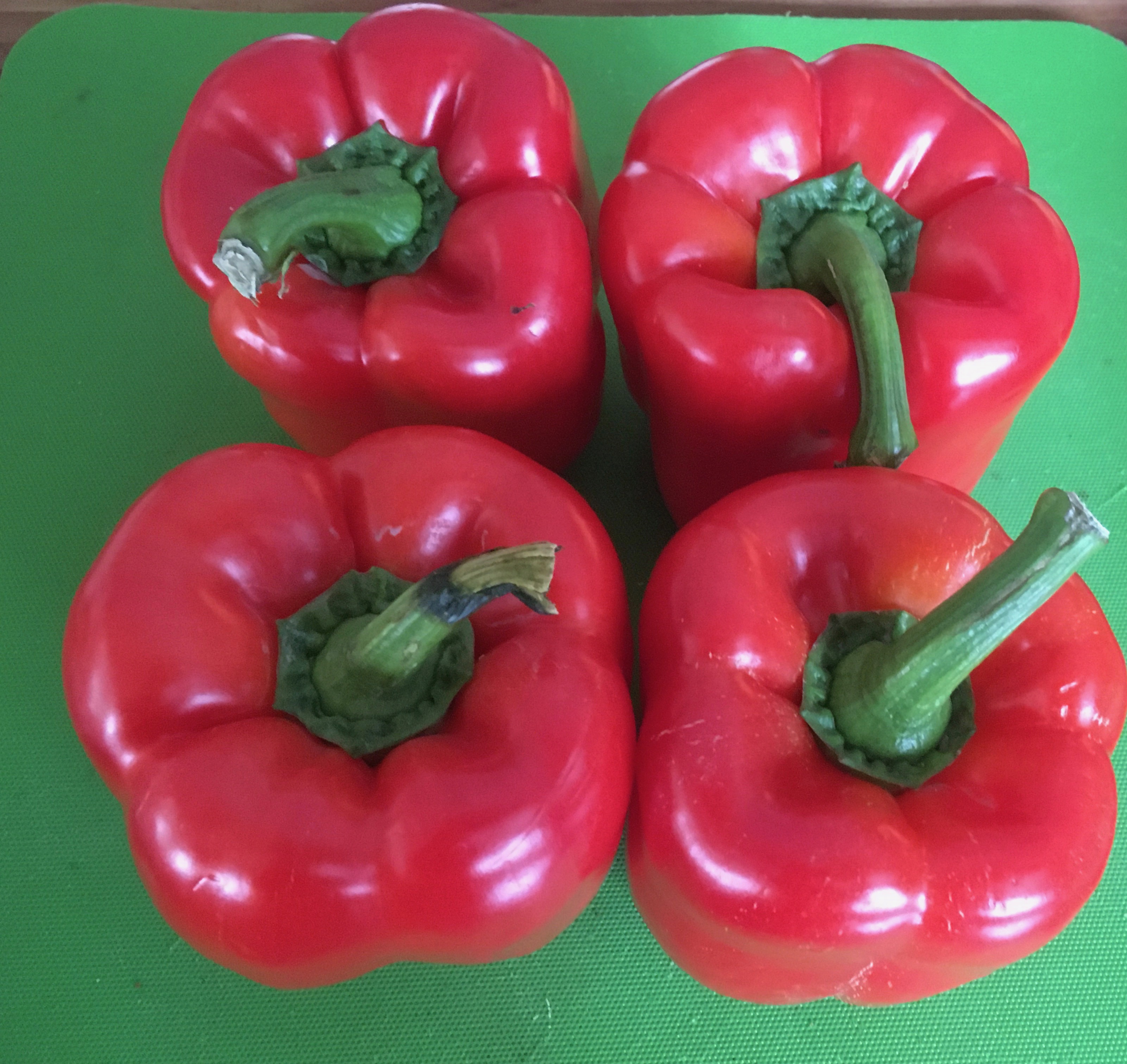 First, we had a little antipasto of marinated roasted red peppers. Here are the peppers ready to be cut
First, we had a little antipasto of marinated roasted red peppers. Here are the peppers ready to be cut After roasting and peeling, Michele marinated them with thick slices of garlic, olive oil and oregano. She leaves the garlic in large pieces so that it is easy to remove them. We ate the peppers with anchovies.
After roasting and peeling, Michele marinated them with thick slices of garlic, olive oil and oregano. She leaves the garlic in large pieces so that it is easy to remove them. We ate the peppers with anchovies. To go with the meatloaf, Michele made sauteed zucchini and onions with cherry tomatoes. She used canned cherry tomatoes. The secret of this recipe is to cook it just to the point where the zucchini are still firm and not mushy.
To go with the meatloaf, Michele made sauteed zucchini and onions with cherry tomatoes. She used canned cherry tomatoes. The secret of this recipe is to cook it just to the point where the zucchini are still firm and not mushy. The saucy vegetables were a nice complement to the meatloaf.
The saucy vegetables were a nice complement to the meatloaf. The meatloaf, called polpettone, is made mostly with beef, and some veal and pork ready mixed with chopped prosciutto, salami and cheese. Here it is ready for the oven
The meatloaf, called polpettone, is made mostly with beef, and some veal and pork ready mixed with chopped prosciutto, salami and cheese. Here it is ready for the oven The meatloaf out of the oven
The meatloaf out of the oven On the plate, the meatloaf was moist and full of flavor, complemented by the sauteed zucchini.
On the plate, the meatloaf was moist and full of flavor, complemented by the sauteed zucchini. Montepulciano D’ Abruzzo 2003 Emidio Pepe100% Montepulciano D’Abruzzo. The winery is organic and Bio-Dynamic. They belong to the Triple “A” Agriculture Artisans Artists. Both the tendone method and the cordon spur method are used for training the vines. In vintages when the weather is very hot the tendone method is better because the leaves form a canopy to protect the grapes from the sun. When the weather is not too hot, the cordon spur is better because it allows more sun and air to reach the grapes. One hectare of tendone has 900 vines and produces 90 quintals of grapes. That means that each vine produces from 6 to 9 kilos of grapes. In one hectare of cordon spur trained grapes, there are 3,300 vines and each vine produces 5 to 6 kilos of grapes. The grapes are crushed by hand and the juice placed in glass-lined cement tanks of 20/25 liters. Only natural yeasts are used, there is no filtration or fining. The wine is transferred to the bottle by hand and the corks are placed in the bottles by hand. This is a very impressive wine with deep red fruit aromas and flavors with hints of cherry, spice and leather. It is still young and will last for many years.
Montepulciano D’ Abruzzo 2003 Emidio Pepe100% Montepulciano D’Abruzzo. The winery is organic and Bio-Dynamic. They belong to the Triple “A” Agriculture Artisans Artists. Both the tendone method and the cordon spur method are used for training the vines. In vintages when the weather is very hot the tendone method is better because the leaves form a canopy to protect the grapes from the sun. When the weather is not too hot, the cordon spur is better because it allows more sun and air to reach the grapes. One hectare of tendone has 900 vines and produces 90 quintals of grapes. That means that each vine produces from 6 to 9 kilos of grapes. In one hectare of cordon spur trained grapes, there are 3,300 vines and each vine produces 5 to 6 kilos of grapes. The grapes are crushed by hand and the juice placed in glass-lined cement tanks of 20/25 liters. Only natural yeasts are used, there is no filtration or fining. The wine is transferred to the bottle by hand and the corks are placed in the bottles by hand. This is a very impressive wine with deep red fruit aromas and flavors with hints of cherry, spice and leather. It is still young and will last for many years.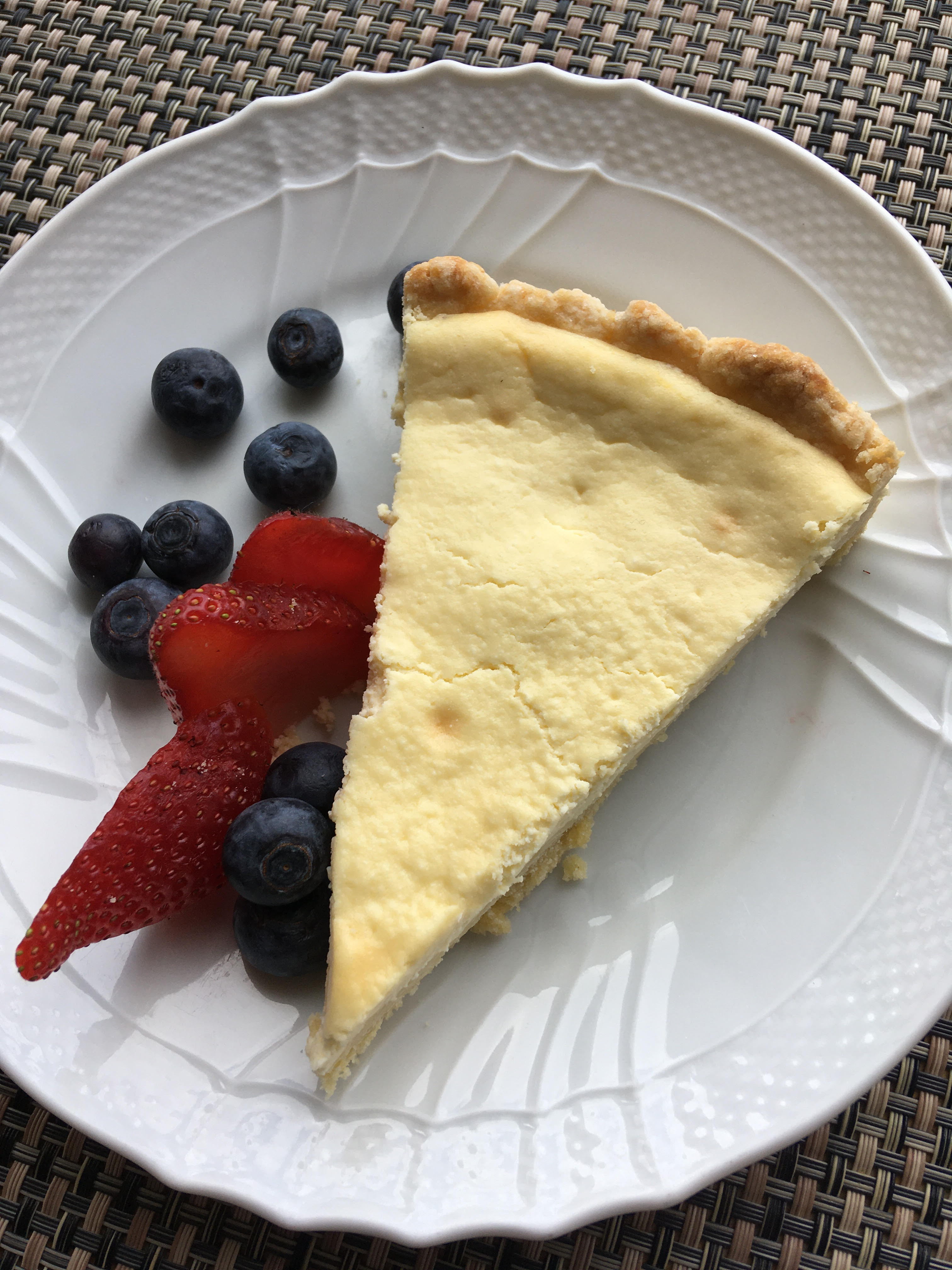 For Dessert, we had a Roman style cheesecake. The recipe is from Michele’s dessert book, La Dolce Vita.
For Dessert, we had a Roman style cheesecake. The recipe is from Michele’s dessert book, La Dolce Vita.  We started with an Alsatian-style tart flambe. It’s a crisp pizza like flatbread topped with caramelized onions, cheese and ham. With it we had…
We started with an Alsatian-style tart flambe. It’s a crisp pizza like flatbread topped with caramelized onions, cheese and ham. With it we had… Trimbach Gewurztraminer 2011 Alsace Contrölé made from 100% Gewurztraminer. The vines are planted on the Ribeauville fault line that fractured 50 million years ago between the Vosges Mountain range and the Black Forest offering a mosaic of terroirs including the complex calcareous limestone and bio-degraded seashell fossils called Muschelkalk. The wine is fermented in temperature controlled stainless steel and concrete vats. There is no secondary malolactic fermentation in order to keep as much natural acid as possible. The wine is released after two years of cellar aging. This is a rich wine with a deep golden color with hints of honey, cinnamon, a touch of spice, a long finish and pleasing aftertaste. The wine was drinking very well and could last for a few more years.
Trimbach Gewurztraminer 2011 Alsace Contrölé made from 100% Gewurztraminer. The vines are planted on the Ribeauville fault line that fractured 50 million years ago between the Vosges Mountain range and the Black Forest offering a mosaic of terroirs including the complex calcareous limestone and bio-degraded seashell fossils called Muschelkalk. The wine is fermented in temperature controlled stainless steel and concrete vats. There is no secondary malolactic fermentation in order to keep as much natural acid as possible. The wine is released after two years of cellar aging. This is a rich wine with a deep golden color with hints of honey, cinnamon, a touch of spice, a long finish and pleasing aftertaste. The wine was drinking very well and could last for a few more years. For the main course we had Choucroute Garni. A mix of different types of sausages, pork, potatoes and sauerkraut slowly cooked with wine and spices.
For the main course we had Choucroute Garni. A mix of different types of sausages, pork, potatoes and sauerkraut slowly cooked with wine and spices. To accompany it, there was a special rye bread studded with caraway seeds.
To accompany it, there was a special rye bread studded with caraway seeds.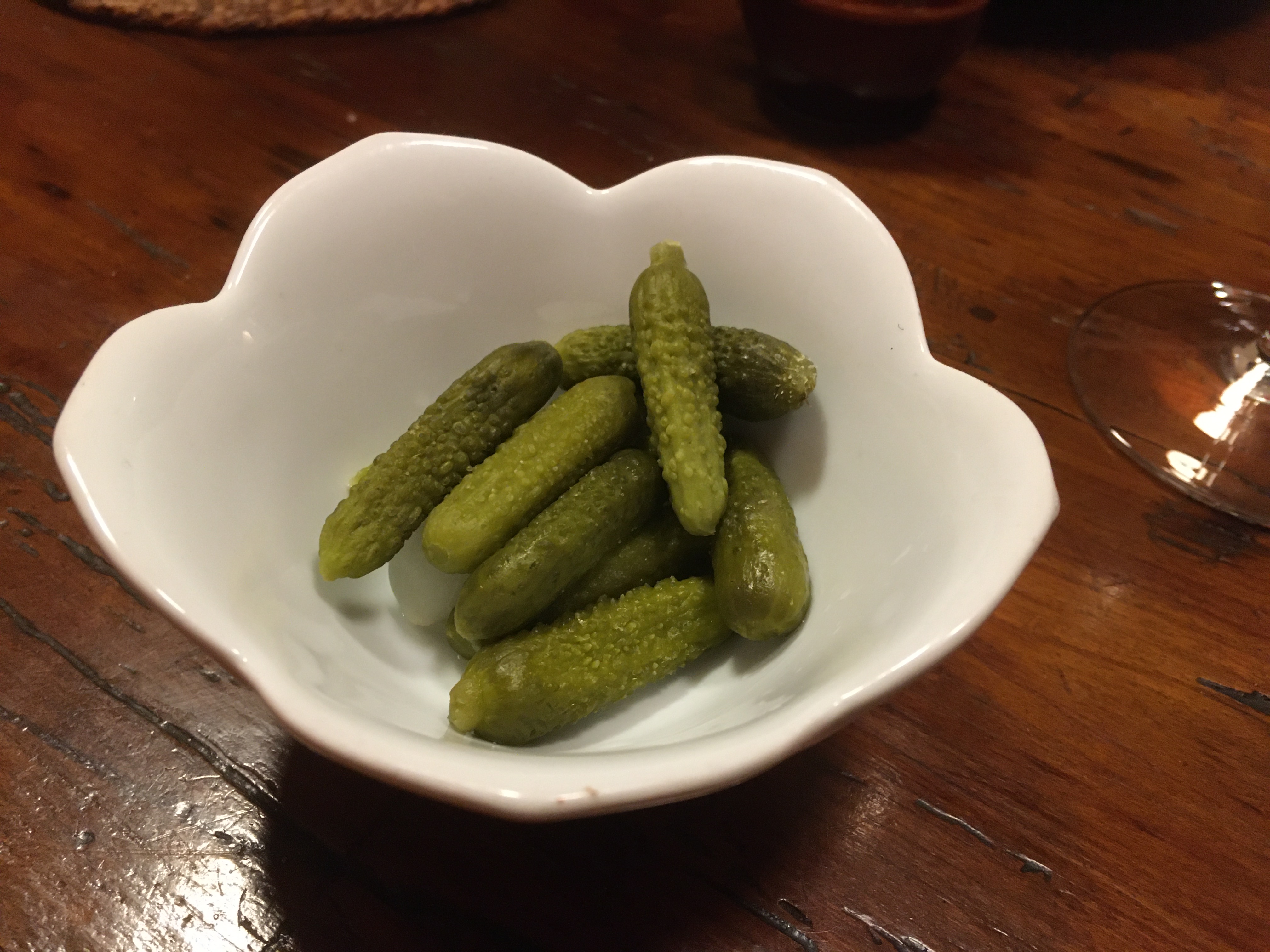 Cornichon pickles, mustard and horseradish accompanied the Choucroute.
Cornichon pickles, mustard and horseradish accompanied the Choucroute. On the plate
On the plate Bockstein Kabinett 2018 Village Ockfen Classification Nil Weis VDP Grosse Lage. Region Mosel Saar Ruwer. The soil is Gray Devonian slate and there are 9,500 plants per hectare. The wine has hints of green apple, pear, and citrus and has a well balanced acidity. It has a steely finish with dry herbal notes.
Bockstein Kabinett 2018 Village Ockfen Classification Nil Weis VDP Grosse Lage. Region Mosel Saar Ruwer. The soil is Gray Devonian slate and there are 9,500 plants per hectare. The wine has hints of green apple, pear, and citrus and has a well balanced acidity. It has a steely finish with dry herbal notes. Dessert was a cool and creamy Coeur ala Creme with raspberry sauce.
Dessert was a cool and creamy Coeur ala Creme with raspberry sauce. Arancini, fried rice balls seasoned with tomato and cheese.
Arancini, fried rice balls seasoned with tomato and cheese. Crostini with anchovies. Simple but the perfect combination of crispy toast and tasty fish.
Crostini with anchovies. Simple but the perfect combination of crispy toast and tasty fish.
